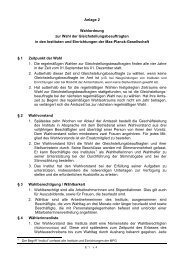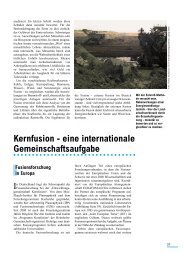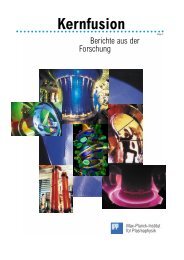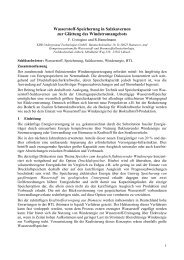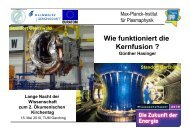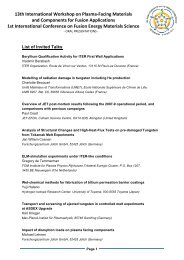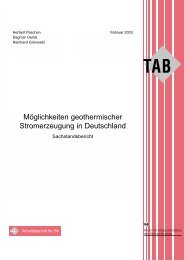IPP Annual Report 2007 - Max-Planck-Institut für Plasmaphysik ...
IPP Annual Report 2007 - Max-Planck-Institut für Plasmaphysik ...
IPP Annual Report 2007 - Max-Planck-Institut für Plasmaphysik ...
You also want an ePaper? Increase the reach of your titles
YUMPU automatically turns print PDFs into web optimized ePapers that Google loves.
VINETA<br />
Head: Prof. Dr. Olaf Grulke<br />
Device and Operational Parameters<br />
VINETA is a long, cylindrical helicon plasma device, specifically<br />
tailored to study plasma waves and instabilities. The nonresonant<br />
rf helicon wave heating provides high plasma densities<br />
at relatively low electron temperatures (n=1019 m-3 , T ≈3eV e<br />
for a rf frequency f =13.56 MHz, rf power of P =5 kW, and<br />
rf rf<br />
magnetic field B=0.1 T). The main diagnostic tools are electrostatic<br />
and magnetic probes. In addition to standard Langmuir<br />
probe diagnostics advanced active induction probes have<br />
been developed to achieve reasonable signal to noise ratios<br />
at the low frequencies of drift wave and Alfvén wave existence<br />
(f=50 kHz). In the high frequency range induction<br />
probes with high capacitive pickup rejection are used for the<br />
measurements of the magnetic wave field of whistler waves.<br />
Nonlinear Interaction of Drift Waves and Driven Parallel Currents<br />
A key feature of the dynamics of drift wave modes and turbulence<br />
is the parallel electron response associated with the<br />
drift wave instability. Using highly sensitive magnetic probes<br />
the parallel current structure of single saturated drift wave<br />
modes has been measured. Figure 1 shows plasma density<br />
fluctuation pattern and the associated perpendicular magnetic<br />
field fluctuations of a m=3 drift wave mode for two phases of<br />
the drift mode in half of the azimuthal cross section. The magnetic<br />
field fluctuations show the signature of parallel current<br />
filaments, which are correlated with the drift mode pressure<br />
perturbations. To directly influence of the parallel drift wave<br />
currents two approaches are persued: First, a shear Alfvén<br />
wave is excited with a frequency close to the drift wave frequency.<br />
The parallel currents of the drift wave and the Alfvén<br />
wave interact nonlinearly, which is observed as frequency<br />
pulling of the drift mode by the Alfvén wave. Second, a more<br />
y [mm]<br />
80<br />
60<br />
40<br />
20<br />
0<br />
-20<br />
-40<br />
-60<br />
-80<br />
-80 -60 -40 -20 0 -80 -60 -40 -20 0<br />
x [mm] x [mm]<br />
Laboratory Plasma Devices WEGA and VINETA<br />
0.3<br />
0.2<br />
0.1<br />
0<br />
-0.1<br />
-0.2<br />
-0.3<br />
Figure 1: Pressure fluctuations (color coded) and associated perpendicular<br />
magnetic field fluctuations (arrows) for a single m=3 drift mode in the<br />
azimuthal plane perpendicular to the ambient magnetic field.<br />
density fluctuations [a.u.]<br />
62<br />
advanced scheme is to drive mode selective parallel currents<br />
either inductively by a set of eight azimuthally arranged magnetic<br />
saddle coils or with electric contactors in the plasma.<br />
With this mode selective current drive we achieved a full<br />
suppression of the drift wave turbulence. Figure 2 shows an<br />
example of a typical power spectral density for drift wave<br />
turbulence as observed in VINETA and the result of the mode<br />
selective current drive with mode number m=2. In the turbulent<br />
state without current drive the spectrum is broad and displays<br />
a power law decrease for frequencies f≥10 kHz. The<br />
spatiotemporal measurement shows incoherent fluctuations<br />
without any distinct mode number. When parallel currents are<br />
driven, drift wave turbulence is fully suppressed and the fluctuation<br />
energy is transferred into a coherent m=2 drift mode.<br />
S [dB] S [dB]<br />
40<br />
0<br />
-40<br />
-80<br />
40<br />
0<br />
-40<br />
-80<br />
0 10<br />
f [kHz]<br />
20<br />
Whistler Waves<br />
In previous measurements we observed a systematic deviation<br />
of the whistler wave behaviour from the linear dispersion<br />
relation at a frequency of roughly half the electron cyclotron<br />
frequency. At this frequency the whistler wave phase velocity<br />
equals its group velocity and it has been suggested that whistler<br />
wave solitons, so-called oscillitons, might be responsible for the<br />
observed deviations. Dedicated measurements of those deviations<br />
and the associated damping of whistler waves in VINETA<br />
revealed first evidence for the existence of whistler solitons. The<br />
unambiguous identification of oscillitons by wave package dispersion<br />
measurements will be the subject of further investigations.<br />
Scientific Staff<br />
Φ [π] Φ [π]<br />
0<br />
2<br />
C. Brandt, O. Grulke, T. Klinger, J. Pfannmöller, K. Rahbarnia,<br />
A. Stark, N. Sydorenko, S. Ullrich, T. Windisch.<br />
2<br />
1<br />
1<br />
0<br />
0 0.5 1<br />
time [ms]<br />
1.5 2<br />
Figure 2: Power spectral density of plasma density fluctuations and associated<br />
spatiotemporal plot of density fluctuation time series along an<br />
azimuthal circumference for the case of drift wave turbulence (top row) and<br />
the controlled situation when a m=2 current pattern is driven<br />
Part of the VINETA program is carried out under the auspices of the Transregional<br />
Special Collaborative Research Center SFB-TR24 “Fundamentals<br />
of Complex Plasmas”.<br />
δ n [a.u.]<br />
δ n [a.u.]






